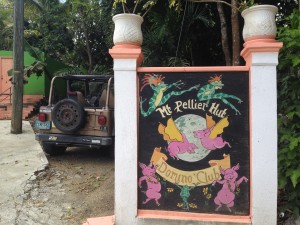For the past few days, we have been lucky enough to have guest lectures from experienced professionals involved in many aspects of turtle work. Mike Evans from the Sandy Point National Wildlife Refuge, Zandy Hillis-Starr from the Buck Island Reef National Monument, Ian Bell, of the Endangered Species Unit in Queensland Australia, Carlos Diez, a researcher with the Department of Natural Resources, as well as our professors Matthew Godfrey and Kelly Stewart, have opened us up to discussions of human involvement in the past, present, and future of sea turtle research and conservation.
In our conversations, an important and controversial topic of discussion has been the interaction of local human communities with turtle populations. From a strictly scientific perspective, and speaking for the turtles, it may seem that human interaction stands only to harm the turtles. In Australia, for example, aboriginal hunting rights have allowed native islanders to harvest sea turtles, which may be negatively impacting the wider population. Poaching and wildlife trafficking remain issues in Puerto Rico, and in St. Croix, tourism and local beach-goers pose a threat to leatherback hatchlings as their nests can easily collapse on them from human footsteps that compact the sand above the hatchlings.
However, the topic is more complicated than simply that human interaction with turtles should be limited. Many of the local communities surrounding important turtle nesting habitats rely on turtles for various reasons. In Australia, turtle hunting remains an important part of traditional aborigine culture. Local legislation in these areas allow for human interaction, whether in the form of hunting rights or by allowing tourist groups access to turtle nesting beaches in order to stimulate the economy.
From a conservationist’s perspective, the situation is more complicated still. With limited funding for sea turtle research and conservation, the concept of human interaction may be important in furthering conservation goals. In raising awareness of locals about turtles and giving them hands-on experience with turtles, turtles may gain important advocates. In Australia, aborigine involvement in capture and release of turtles for tagging initiatives is the primary way in which scientists have the opportunity to encourage those with hunting rights to think of other ways that they might positively interact with turtles and mold future community leaders to have turtles in mind. In St. Croix, turtle watch groups have the opportunity to accompany researchers at Sandy Point National Wildlife Reserve during nesting season, when the beach is off-limits, in the hopes of showing them a nesting turtle that may help foster community support for conservation in the area. Turtle work can also be quite labor intensive and community involvement is paramount to the continuation of turtle research programs, whether it is in small areas like Sandy Point, or in areas where turtles nest over a much wider range, such as loggerheads in North Carolina, where volunteers play a critical role in covering coastline that a few researchers simply could not do on their own.


Today we visited two local businesses that demonstrate how humans and nature can benefit from interacting with one another. First, we visited the Mt. Pellier Hut Domino Club, a family owned business that sells O’Doul’s non-alcoholic beer to tourists who wish to feed the beer to the family’s hogs. The tourists love it, the family relies on it, and the hogs appreciate the love. We also visited a local mahogany workshop that partners with LEAP and uses fallen trees to create beautiful works of art.


In the evening, Kelly lectured on genetics studies, which are giving us insight into the complexities of turtle reproduction dynamics. Since research on land can be much more thorough than in-water and male turtles rarely come on land while females must do so to nest, we know far more about females than we do about males. However, genetics studies such as the program Kelly runs at Sandy Point are offering us insight into the interaction between breeding males and females. From looking at genetic markers in hatchlings and their mothers, researchers are able to discern the genetic profile of the fathers. Once fathers are identified, their relative reproductive success can be compared from the hatching rates of the clutches. Genetics studies are forging a path for researchers to discover more and more about aspects of sea turtle life that cannot be directly observed.
